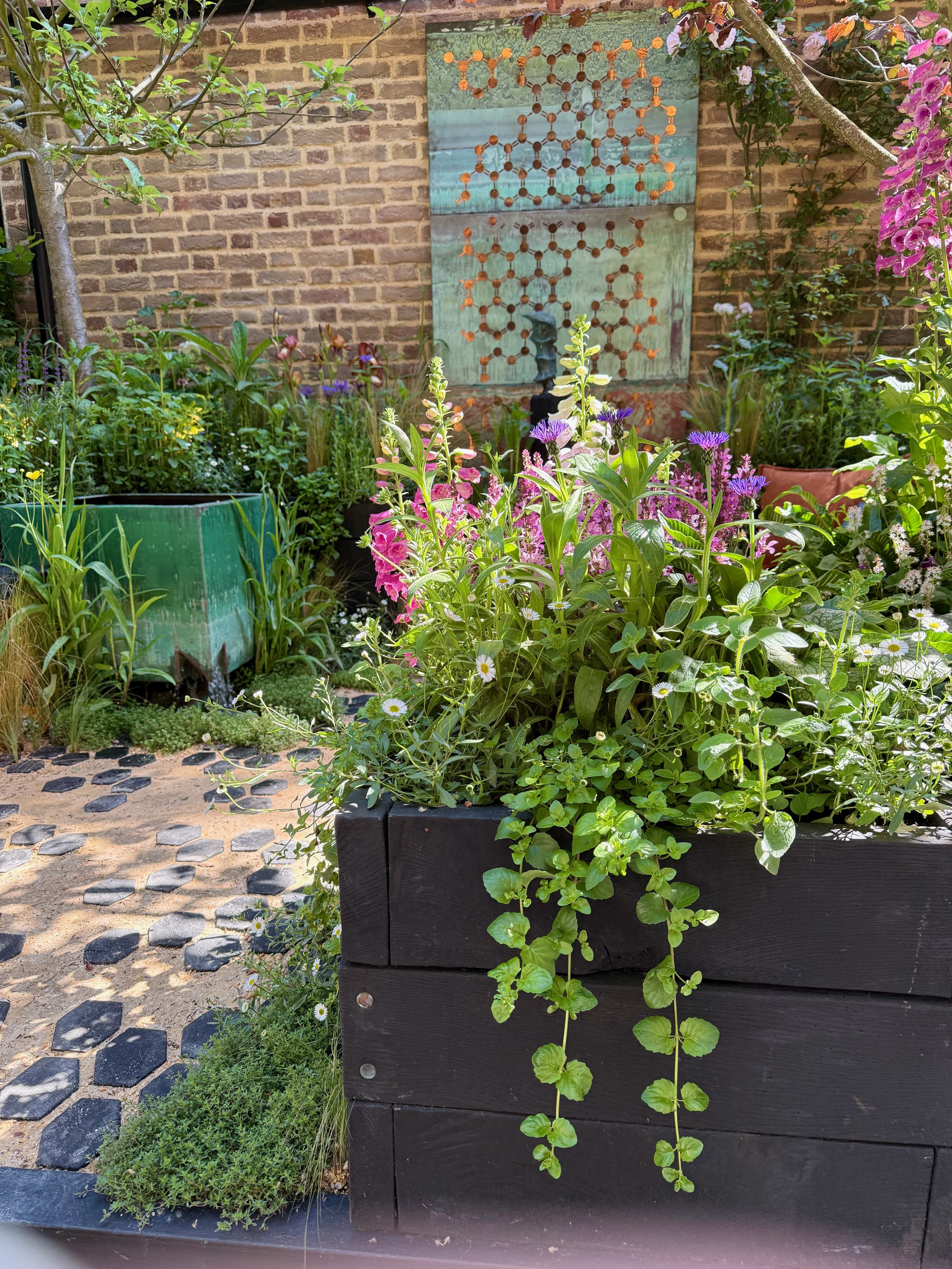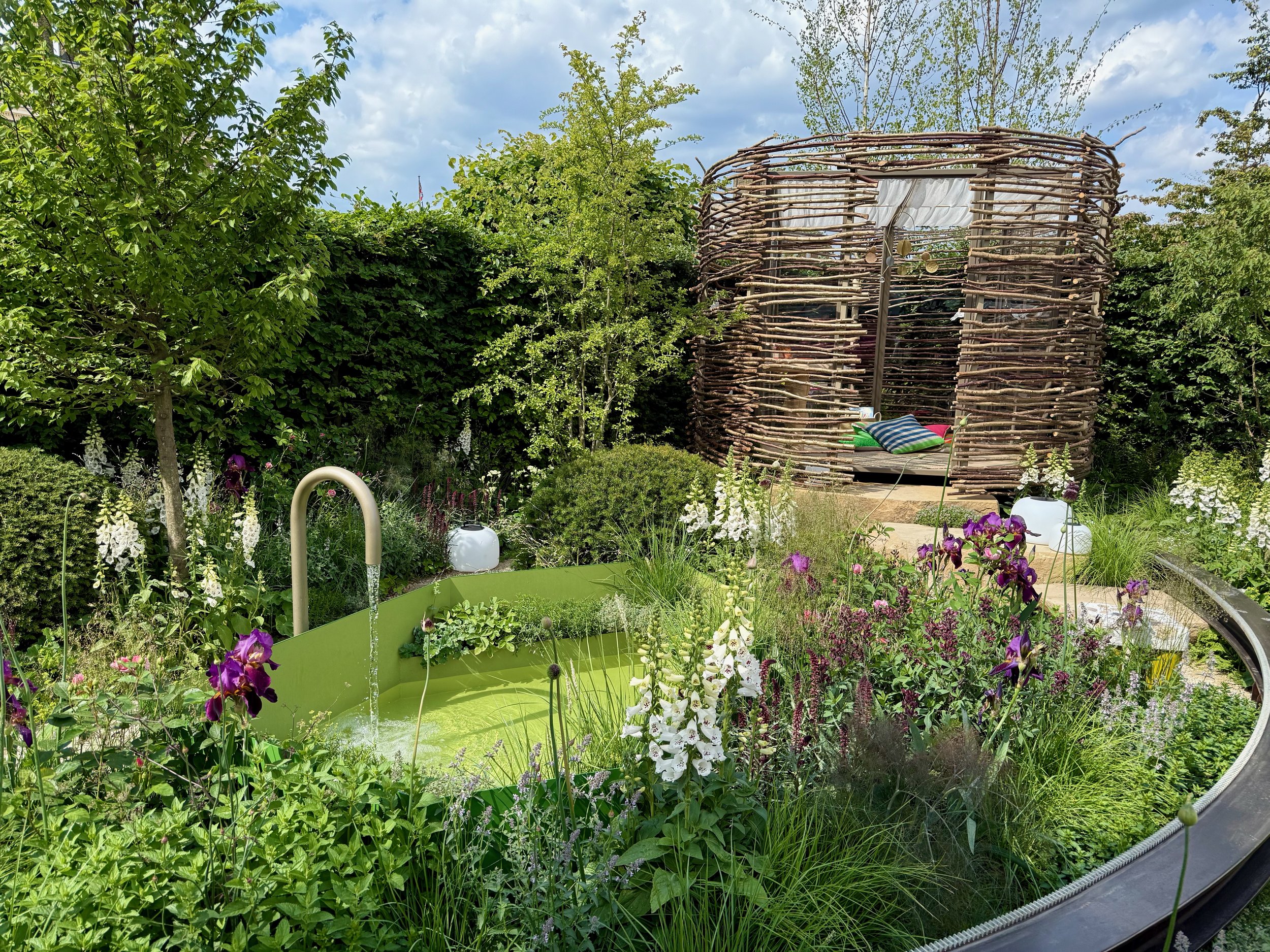Garden Design Inspiration
Creative Ways to Add Trees
to Your Yard or Garden
from the 2025 Chelsea Flower Show
This is part of a series about design ideas from the 2025 Chelsea Flower Show.
You’ll find all of my posts here.
Tree Trends for Modern Gardens:
What to Plant and Why
When we purchase or rent a home – whether it is a large piece of property or an urban balcony – generally trees have already been chosen for us. Our current home had four trees when we moved in, two of which we have subsequently removed because they were diseased. So trees have been front of mind as I have created our gardens. And I find myself paying attention to trees in new and different ways as I think about them as creators of shade, habitat for creatures, and occupants of our planet many of whom have longer life spans than me.
Choosing a tree is a long-term commitment. Growing a tree is an investment in resources and time – and that tree may well out-live you. But surrounding yourself with trees is an investment in your well-being and in the ecosystem in which you live. Birds and squirrels and butterflies and insects will, if you choose wisely, find rest and sustenance in your trees. Trees will create shade. They will add drama. And they will mark your space for decades to come.
So trees should absolutely be part of your garden design!
The Chelsea show gardens certainly featured a lot of BIG trees that were moved in with cranes and relocated after the show closed. The Prince's Trust Garden designed by Joe Perkins featured towering Black Pines at 14 meters tall – and there were large, mature trees in most of the show gardens. Indeed the grounds of the Royal Hospital Chelsea feature so many gorgeous trees, too, including an avenue of Plane Trees which were dropping pollen in huge clouds (achoo!).
But I found myself attracted to the small trees — and there were a lot of them.
Are small trees on-trend? Well, perhaps even more now than they have been before. They are great at a flower show, of course, because they are easier to move. But they weren't selected just for their convenience. These smaller trees whether they were planted in pots or in the landscape made a statement. And I noted three design trends in trees which I think are fabulous for home gardeners:
Multi-Stemmed Trees | Sculptural & Dramatic
Multi-Stemmed Trees: I love multi-stemmed trees. They are living sculptures. And there are some practical reasons to use multi-stemmed trees in a garden.
Lower water usage: a smaller tree requires less water
Size control: using a coppice pruning technique, even trees which would on their own grow very tall can be kept to a more manageable size allowing you to plant a multi-stemmed tree in an area where a large tree could never grow
Visual impact: some multi-stemmed trees have twisty trunks, others straight. Their bark and leaves vary, too. They can be so beautiful in a relatively small and compact space — and can even still benefit wildlife while fitting into a human-scaled environment.
When you are looking for a multi-stemmed tree, you'll need to go to a nursery and look specifically for one that fits your needs. Many species, like Amelanchier, for example may be sold as multi-stemmed or as single-stemmed trees. So you'll need to look for one which suits your needs.
A tree standing sentinel on the edge of the Garden of Compassion by Tom Hoblyn.
Trees to try:
Chionanthus virginicus | American Fringetree
Sambucus canadensis | American Elderberry
Hamamelis virginiana | Common Witchhazel
A Note about Dogwood Trees
Cornus kousa looking gorgeous in the A Space to Read Balcony Garden.
Dogwoods were everywhere at the Chelsea Flower Show. But almost every specimen that I saw was a variety of Cornus kousa – a Chinese dogwood. They are beautiful, but they are on the Invasive Species list in New Jersey and other states. And we don't plant invasive plants! So, rather than choosing an exotic Dogwood, consider our native dogwoods including:
Cornus sericea | Red Twig Dogwood
Cornus amomum | Silky Dogwood
Cornus racemosa | Gray Dogwood
For more ideas, consult this article by Sarah Middeleer for the Ecological Landscape Alliance which has a rich list of native North American large shrubs and small trees.
Trees in Pots & Containers | Ready for a Close Up
Trees in Containers: many of those multi-stemmed trees were planted in containers. The idea of trees in containers is often used in high-end and commercial design, but when you choose the right trees (not a grand oak, but something more adaptable), you can bring trees right into your outdoor living spaces. Plus, you can have many more trees because you don’t have to plan for a giant canopy. To successfully grow trees in containers, you’ll need to consider:
Container size: you need a large pot to support a tree, and you’ll need to repot every few years to refresh the nutritional supply for the tree.
Pruning: whether it is through coppicing or other pruning techniques, pruning will be an important part of maintaining a potted tree for its lifetime. This will keep the tree healthy and happy and at a manageable size, too.
Life-span: planting a tree in a container will reduce its life-span. But you could plant a young tree in a pot for a few years, and then plant it out into your landscape. Remember: not using perennials as annuals is one of our Resistance Gardening tips!
An olive tree was one amongst several potted trees in Ashleigh Aylett’s Blue Mind Garden which won Best Balcony/Container Garden.
Trees to try:
Corylus americana | Hazelnut
Diervilla lonicera | Yellow bush-honeysuckle
Fothergilla gardenii | Fothergilla
Hamaelis virginiana | Witch hazel
Kalmia latifolia | Mountain laurel
Vaccinium coryumbosum | Blueberry (any variety is a cultivar of a native North American plant)
Viburnum cassinoides, V.dentatum | Viburnum
Viburnum prunifolium | Black Haw
For more suggestions and ideas, I recommend this article by Jeremie Fant for Wild Ones about their own balcony garden in Chicago over the years which has an excellent downloadable list of plants, too.
What You Can Do At Home
Remember that a container doesn't have to be a big terracotta pot purchased at a garden center. In fact, terracotta is so heavy, it might not be the best choice, depending on where you live. But again turn to FBMP or other marketplaces. People who are moving often have to get rid of their big pots – and you might find something cheap.
And containers can be anything. Just put some holes in the bottom for drainage, and put it up on some stones or feet of some kind so the water can run away.
Check out my cheap DIY container gardening ideas here:
Shaped Trees & Topiary | Shapely & Timely
Topiary Trees and Shrubs: when we think of topiary, we may think of the wacky and wonderful topiaries at Disneyland, but intentionally-shaped trees and shrubs pruned into balls or other shapes are all topiaries, and across the flower show grounds, topiary had its day. The most common shape was topiary balls, and they were incredibly effective. From the topiary balls in Monty Don’s Dog Garden to the purply Beech balls in Jo Thompson’s Glasshouse Garden, elegant ball topiary were everywhere. They break up full borders and provide a wonderful focal point at a bend to a path or a transition point.
The Impatient Gardener called out Jo Thompson’s beech balls as she was watching TV coverage as the show began, and I can confirm: they are stunning! However, Beech is threatened in North America by Beech Leaf Disease, and I’m not sure I would plant Beech right now as a result. But those topiary are really, really tempting! I'm wondering if there is another plant that would give us the same impact.
Some plants have been cultivated to have a natural "globe" form. Others require significant pruning twice per year to maintain their shape, so choose according to your tolerance for yard work. I always recommend choosing native North American species, but topiary is an art form that developed elsewhere, so the more common trees used for topiary are not native to North America.
Personally, I came home and immediately bought a Cotinus coggygria – Smoke Tree, a native North American plant. I don't mind pruning, which my Smoke Tree will need, but it has a beautiful globe form, and I'm really excited about the beautiful form it adds to my garden. I might need a few more!
A round shrub reflects the tennis ball theme in Monty Don’s Dog Garden.
Trees to try:
Pinus sylvestris 'French Blue' | French Blue Scotch Pine
Picea glauca 'Conica' | Dwarf Alberta Spruce
Juniperus chinensis 'Spartan' | Juniper
Buxus sempervirens | Boxwood – but box blight has arrived in the US, so consider carefully
Myrica californica | Pacific Wax Myrtle
Picea pungens 'Globosa' | Globe Blue Spruce
Tree Trend Alert!
Ginkgo biloba 'Globosa', also known as the Globe Maidenhair Tree, is a dwarf cultivar of the iconic Ginkgo tree, and Dr. Catherine MacDonald included several in her Raindance Garden. They are STUNNING! I don’t see them for sale yet in the US, but I do see them in Canada.
Growers: get these into the stores! I need one!
Tips for Success with Small Trees in your Yard or Garden
As you consider adding smaller trees to your landscape, there are three things you can do to give your tree the best possible start at life:
Buy the smallest tree you can find. For fruit trees, for example, this means planting bare-root whips. But studies show that the smaller the tree is, the better rooted it becomes and the more likely it is to survive long-term.
Plant your tree properly. There is more to it than just digging a hole, actually. This guide gives you detailed instructions based on the best scientific research available. And when digging, the shape, size, and depth of the hole all matter.
Water your tree. Consult your local Master Gardener office on this, but for the most part: if you are west of the Mississippi River, you will probably need to water your tree for the long term. Here in Colorado, we recommend watering weekly in the summer unless we have had rain, and every 2-3 weeks in the winter unless we have had snow. The bigger your tree is, the more water it needs, too. But the biggest cause of tree death is lack of water, and with a changing climate, this has become more and more necessary.
I am excited to try some of these trends in my own garden, and I hope you will, too! And if you do, let us know! I'd love to see what you plant and how it looks!
Don’t forget to subscribe to my Substack so you can get this and all kinds of other gardening goodness in your inbox.
Happy Gardening!































